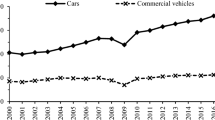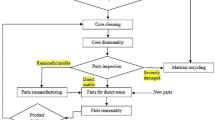Abstract
The management of many products during their end-of-life stage has not been addressed fully in Thailand. Today, the owners of dismantling facilities and car repair shops are managing end-of-life vehicles (ELVs) increasingly. This ELV market system involves recovering ELVs’ valuable materials and components. At present, information on ELVs’ current status is limited, and this lack of information will lead eventually to managing ELVs improperly. This paper presents an overview of the current status of ELV management in Thailand and proposes an appropriate way to improve it. The objectives of this study are to: (1) estimate the number and distribution of passenger cars (four wheels, but less than seven seats); (2) understand ELV stakeholders’ geographic locations to show the scarcity of ELV hotspots, dismantlers, and recycling industry facilities;(3) study the life cycle of greenhouse gas emissions (LCA GHGs) and the value chain in ELV management; and (4) provide recommendations for an ELV management policy. Field data were collected from key stakeholders in the supply chain. The results showed that a significant number of ELVs are discarded annually, and very few ELVs were sent to recycling facilities. ELVs’ LCA GHGs were estimated to be 540.9–1344 kg CO2e/car. In addition, the value added in ELV management could be in the range of 58–92 million THB million a year (USD 1.7–2.8 million) if these ELV parts are recycled, and recycling ELVs could reduce CO2e emissions by 92,767–159,952 tons.
Graphic abstract








Similar content being viewed by others
References
Andersson M, Söderman ML, Sandén BA (2017) Lessons from a century of innovating car recycling value chains. Environ Innov Soc Transit 25:142–157
Arora N, Bakshi SK, Bhattacharjya S (2019) Framework for sustainable management of end-of-life vehicles management in India. J Mater Cycles Waste Manage 21:79–97
Barcena Ruiz JC, Casado Izaga FJ (2014) Regulation of waste management under spatial competition. J Clean Prod. https://doi.org/10.1016/j.jclepro.2014.12.052
Bellmann K, Khare A (2000) Economic issues in recycling end-of-life vehicles. Technovation 20:677
Chen KC, Huang SH, Lian IW (2010) The development and prospects of the end-of-life vehicle recycling system in Taiwan. Waste Manage 30:1661–1669
Chen M (2006) Sustainable recycling of automotive products in china: technology and regulation. J Min Met Mat Soc 58:23–26
Coates G, Rahimifard S (2008) A cost estimation framework to support increased value recovery from end-of-life vehicles. Int J Comput Integr Manuf 21:895–910
Dalmijn LW, De Jong RPT (2007) The development of vehicle recycling in European: sorting, shredding, and separation. J Min Met Mat Soc 59:52–56
Davis SC, Williams SE, Boundy RG, Moore S (2015) 2015 Vehicle technologies market report. Oak Ridge National Laboratory, Springfield, VA
Duval D, Maclean HL (2007) The role of product information in automotive plastics recycling: a financial and life cycle assessment. J Clean Prod 15:1158–1168
Ecobalance UK (The Ecobilan Group) (2015) Application of Life Cycle Assessment to Investigate Options for Disposal and Processing of End of Life Vehicles in 2015.
European Automobile Manufacturers Association (2017) Average Vehicle Age. https://www.acea.be/statistics/tag/category/average-vehicle-age. Accessed December, 2018
Farel R, Yannou B, Ghaffari A, Leroy Y (2013) A cost and benefit analysis of future end-of-life vehicle glazing recycling in France: a systematic approach resources. Conserv Recycl 74:54–65
Ferrao P, Nazareth P, Amaral J (2006) Strategies for meeting EU end-of-life vehicle reuse/recovery targets. J Ind Ecol 10:77–93
Fonseca AS, Nunes MI, Matos MA, Gomes AP (2013) Environmental impacts of end-of-life vehicles’ management: recovery versus elimination. Int J Life Cycle Assess 18:1374–1385
Gerrard J, Kandlikar M (2007) Is European end-of-life vehicle legislation living up to expectations? Assessing the impact of the ELV Directive on ‘green’ innovation and vehicle recovery. J Clean Prod 15:17–27
Go TF, Wahab DA, Rahman MNA, Ramli R, Azhari CH (2011) Disassemblability of end-of-life vehicle: a critical review of evaluation methods. J Clean Prod 19:1536–1546
Kanari N, Pineau JL, Shallari S (2003) End-of-Life Vehicle Recycling in the European Union. https://www.tms.org/pubs/journals/JOM/0308/Kanari-0308.html. Accessed July 2016
Karagoz S, Aydin N, Simic V (2019) End-of-life vehicle management: a comprehensive review J Mater Cycles. Waste Manage. https://doi.org/10.1007/s10163-019-00945-y
Kim K-H et al (2004) Management status of end-of-life vehicles and characteristics of automobile shredder residues in Korea. Waste Manage 24:533–540
Koshiba K (2006) The recycling of end-of-life vehicles in Japan. https://www.japanfs.org/en/news/archives/news_id027816.html. Accessed July, 2018
Kumar S, Yamaoka T (2007) System dynamics study of the Japanese automotive industry closed loop supply chain. Journal of Manufacturing Technology Management 18:115–138
Li W, Bai H, Yin J, Xu H (2016) Life cycle assessment of end-of-life vehicle Recycling processes in China Take Corolla Taxis for Example. J Clean Prod 117:176–187
Maierbrugger (2013) Thailand’s First-Car Buyer Incentive Scheme A Failure. https://investvine.com/thailands-first-car-buyer-incentive-scheme-collapsed/. Accessed February, 2017
Majeau-Bettez G, Hawkins TR, Strømman AH (2011) Life cycle environmental assessment of lithium-ion and nickel metal hydride batteries for plug-in hybrid and battery electric vehicles. Environ Sci Technol 45:4548–4554
Mangmeechai A (2016) An economic input-output life cycle assessment offood transportation in Thailand. Int J Environ Stud 73:778–790
Mangmeechai A (2017) Moving towards sustainable end-of-life tire management from the cost and environmental perspectives: a case study of Thailand. Int J Technol Policy Manag 17:77–93
Mohamad-Ali N, Ghazilla RAR, Abdul-Rashid SH, Ahmad-Yazid A (2019) Aftermarket survey on end-of-life vehicle recovery in Malaysia key findings. J Clean Prod 211:468–480
MP Battery (2019) Car battery prices. https://batterymittapap.com/%E0%B8%A3%E0%B8%B2%E0%B8%84%E0%B8%B2%E0%B9%81%E0%B8%9A%E0%B8%95%E0%B9%80%E0%B8%95%E0%B8%AD%E0%B8%A3%E0%B8%B5%E0%B9%88%E0%B8%A3%E0%B8%96%E0%B8%A2%E0%B8%99%E0%B8%95%E0%B9%8C/?gclid=CjwKCAjwr8zoBRA0EiwANmvpYNK9stArFrjMIXvsk6mknEeP9tu8CJhNJDDWWmZDqBQSF-DkPrO8kBoCJXQQAvD_BwE. June 2019
Naik TS (2018) End of Life Vehicles Management at Indian Automotive System. Jönköping University
Office of Energy Efficiency and Renewable Energy (2017) Average Age of Cars and Light Trucks Was Almost 12 Years in 2016. Washington DC, U.S, Department of Energy
Ohno H, Matsubae K, Nakajima K, Kondo Y, Nakamura S, Nagasaka T (2015) Toward the efficient recycling of alloying elements from end of life vehicle steel scrap resources. Consev Recycl 100:11–20
Pavasant P, Mangmeechai, A., Kanokkantapong, V., Wongsuchoto, P., Panyapinyopol, B., Poopa, T., Sirinam, S., Prasitwuttisuk, W. and Suesareetham, N. (2014) Policy Analysis on End of Life Tire Management in Thailand. Grand number RDG5650136, National Research Council of Thailand, Bangkok
Phoboon C (2014) Life Cycle Assessment and Application to Provide Policy Recommendations for Energy Consumption and Greenhouse Gas Emission Reduction in Transport Sector According to 20-Year Energy Conservation Plan. Dep Altern Energy Dev Energy Conserv, Bangkok
Sakai S, Noma Y, Kida A (2007) End-of-life vehicle recycling and automobile shredder residue management in Japan. J Mater Cycles Waste Manage 9:151–158
Sakai S et al (2014) An international comparative study of end-of-life vehicle (ELV) recycling systems. J Mat Cycles Waste Manage 16:1–20
Sakkas N, Manios T (2003) End of life vehicle management in areas of low technology sophistication a case study Greece. Bus Strategy Enviro 12:313–325
Sawyer-Beaulieu SS, Tam EKL (2005) Applying Life Cycle Assessment (LCA) to North American End-of-Life Vehicle (ELV) Management Processes SAE Technical Paper 2005–01–0846 doi:https://doi.org/10.4271/2005-01-0846
Schultmann F, Zumkeller M, Rentz O (2006) Modeling reverse logistics tasks within closed-loop supply chains: an example from the automotive industry. Eur J Oper Res 171:1033–1050
The Statistics Portal (2017) Projected U.S. vehicle age from 2017 to 2019 (in years). https://www.statista.com/statistics/738667/us-vehicles-projected-age/. Accessed December, 2018
The Thailand Greenhouse Gas Management Organisation (TGO) (2017) Emission factors. https://thaicarbonlabel.tgo.or.th/admin/uploadfiles/emission/ts_822ebb1ed5.pdf. January, 2017
Transport Statistics Sub-Division (2020) Number of Vehicle Registered in Thailand. Department of Land Transport,
Xia X, Li J, Tian H, Zhou Z, Li H, Tian G, Chu J (2016) The construction and cost-benefit analysis of end-of-life vehicle disassembly plant: a typical case in China. Clean Technol Environ Policy 18:2663–2675
Zhao Q, Chen M (2011) A comparison of ELV recycling system in China and Japan and China’s strategies resources. Conserv Recycl 57:15–21
Acknowledgements
This funding was provided by National Research Council of Thailand (Grant No. NRC 2560A12002006).
Author information
Authors and Affiliations
Corresponding author
Additional information
Publisher's Note
Springer Nature remains neutral with regard to jurisdictional claims in published maps and institutional affiliations.
Electronic supplementary material
Below is the link to the electronic supplementary material.
Rights and permissions
About this article
Cite this article
Mangmeechai, A. Life-cycle greenhouse gas and value chain of end-of-life vehicle management in Thailand. Clean Techn Environ Policy 24, 1113–1128 (2022). https://doi.org/10.1007/s10098-020-01953-5
Received:
Accepted:
Published:
Issue Date:
DOI: https://doi.org/10.1007/s10098-020-01953-5




